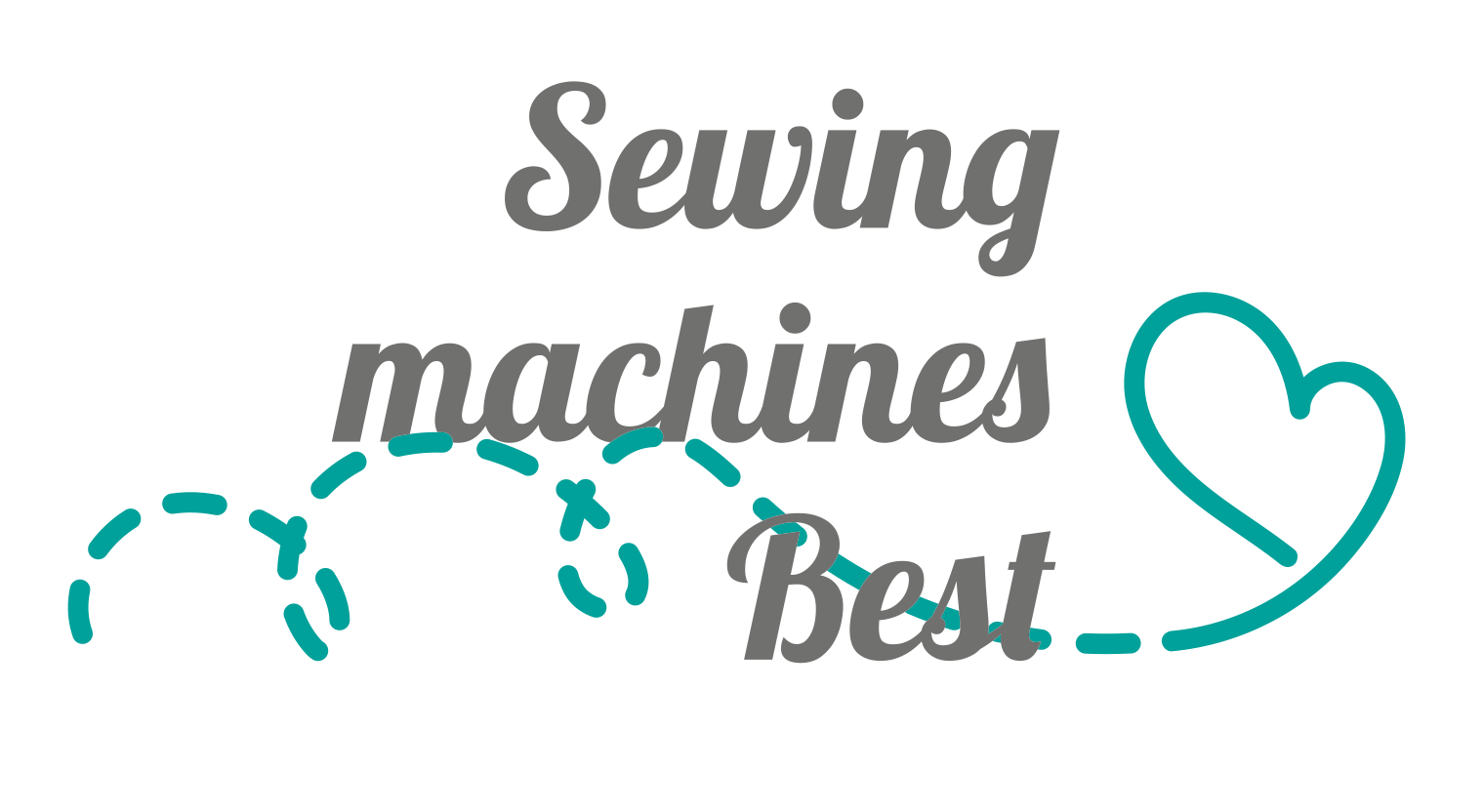Using the right sizes and types of sewing machine needles for your project can mean the difference between broken stitches, skipped stitches, and perfect sewing for a professional look. The sewing machine needle is available in various packaging styles.
It is very important that the needle is suitable for your machine if you want it to work properly, especially for materials such as cotton. If you are going to be stitching on cotton, this article will help you choose the type of needle for this project.
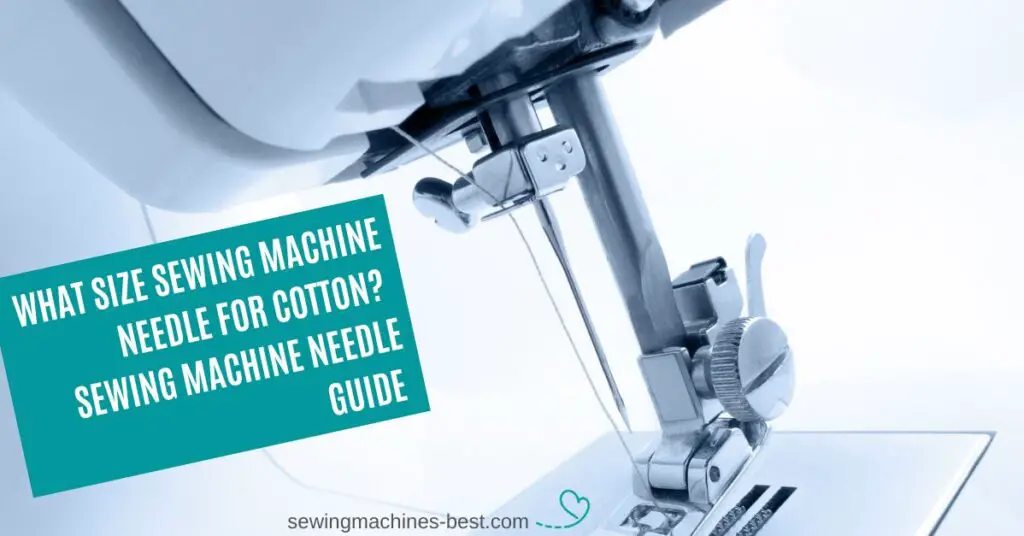
Contents
- 1 What is the size of the sewing machine needle for cotton?
- 2 How to determine the type of needle for sewing cotton
- 3 Leather needles
- 4 Sewing machine needle parts
- 5 What size sewing machine needle should I use for cotton?
- 6 How does a sewing machine needle work?
- 7 How long do sewing machine needles last?
- 8 What do the size numbers on sewing machine needles mean?
- 9 Explanation of the size chart of sewing machine needles
- 10 FAQ
- 11 Conclusion
What is the size of the sewing machine needle for cotton?
The best cotton needles are medium size needles like 80/12, and 90/14. They work well with quilted pieces of cotton, light upholstery, denim, silk dupioni, and other similar fabrics. The eye of the needle is designed for common sewing threads such as universal polyester and 50 gauge cotton.
How to determine the type of needle for sewing cotton
There are other types of sewing machine needles designed for different fabrics; the Cotton fabric is usually sewn using 80/12 and 90/14 needles. These sizes are the most recommended, but do not limit the use of other types of needles for your project.
The decision to use any cotton needle depends on your level of experience and the availability of such a needle. Below is a list of different needles and their functions on various sewing materials.
Top stitch needles
Topstitch needles have a very sharp point that easily pierces all types of fabrics, and a large eye allows you to use thick topstitch thread.
Universal needle
Utility needles are the universal needle in the world of sewing. Universal points are slightly rounded than sharp, but sharper than ballpoints. Your sewing machine most likely came with a set of universal needles!
They work well with most types of fabrics, from woven to knit. Many novice seamstresses don’t even think about replacing the standard needles! However, for the best possible results, you will probably want to match the fabric to the universal needle that works best with it.
Sharp needle
Sharp needles are best for general sewing, with stretch needles being best for light fabrics.
Quilting needle
Quilting needles have a larger eye and thicker shank than other needles, making them ideal for stitching quilts.
Quilting machines and household sewing machines may not always work with the same types of quilting needles, so be sure to read the product description before purchasing.
Ballpoint needle
Ballpoint needles have a slightly rounded tip than universal needles, which spread the fibers of the fabric rather than cut them.
This makes round point needles ideal for ribbed, interlock, cotton jersey, fleece, double jersey, and generally most knit fabrics because it prevents them from slipping or slipping as a result of stitching. Polyester and polyester/cotton blend threads are best for use with round-point needles, and thinner threads should be used with finer a needle.
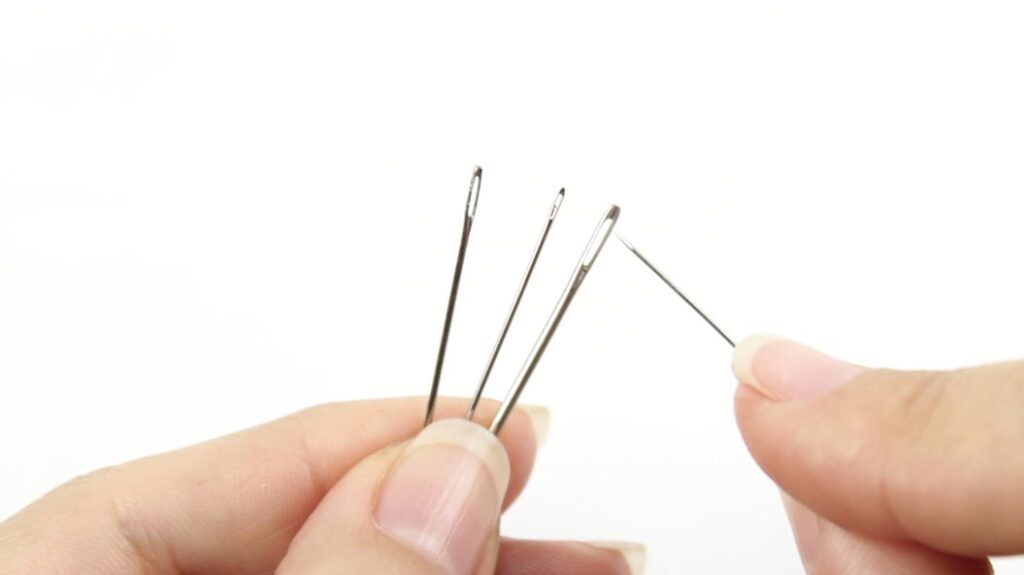
Leather needles
Leather needles are often referred to as chisel point needles due to the point that looks and acts like a chisel when used. Yes, you guessed it, these a needle should be used with genuine leather, suede, and difficult-to-sew items, but they cannot be used with PU faux leather, ultra suede, or synthetic suede as the characteristics of these fabrics are very different from their real counterparts.
Jeans needle
No prizes for guessing the fabric these a needle is for! Yes, denim is the most obvious choice, but these needles are also best for other heavy fabrics such as heavy twill, canvas, and heavy linen, which are often used for workwear.
While ballpoint elastic needles are designed not to cut through fabric, denim needles have a very sharp point and a stronger shaft to prevent the needle from bending or breaking and pushing through heavy fabric. When working with these a needle and fabric, choose synthetic or blended threads, 100% polyester, heavier topstitch threads, and cotton-wrapped polyester.
Stretch needle
Stretch needles have a special groove above the eye, called a scarf. The scarf allows the stretch needles to place the thread very close to the hook or looper, preventing skipped stitches. This works best with stretchy fabrics such as spandex or stretches knit.
Sewing on stretch fabrics is often difficult because the fabric stretches and slips as you sew.
Working with a special stretch needle helps prevent any wiggle room and skipped stitches while working!
Serger
These durable needles are specially designed for overlockers. The pointed tip provides versatility for use with all fabrics. These a needle differ in size from regular sewing machine needles. Check the manual for the correct needle. Change the overlock needle after 15 hours of overcasting.

Sewing machine needle parts
It will be easier for you to understand the different types and styles of needles if you first become familiar with the anatomy of a typical needle.
Shoulder: A square tang curves towards a thinner blade, and this curve is called a shoulder. The shoulder actually goes through the fabric as the needle moves up and down, creating a wider hole for the thread to pass through.
Blade: As you would expect, the blade is a long, sword-like section that runs from the shoulder to the eye. Different types of needles have thicker or thinner blades, depending on their purpose.
Scarf: Some types of points have a slight dip before the blade meets the eye. This indentation, called the scarf, allows the thread to get close to other parts of the machine, such as the looper.
Eyelet: The eyelet is the hole through which the thread is threaded on the pointed lower end of the needle. You may find some differences in the size or shape of the eyes.
Point: if you run your finger under the lowest end of the needle, you will feel its point! You will find varying degrees of sharpness depending on the style. As a rule, a sharp point works well with fabrics, and a rounded point works well with knitwear.
All of these parts work together to allow the needle to pierce the fabric. Then it passes the upper thread through this hole and allows it to catch on the looper or hook. This allows the bobbin thread to pass through it, creating a stitch!
Knowing the correct names for all the parts of a sewing machine will make you feel like an expert, but it will also help you understand the instructions in the user manual or any other sewing reference you want to use.
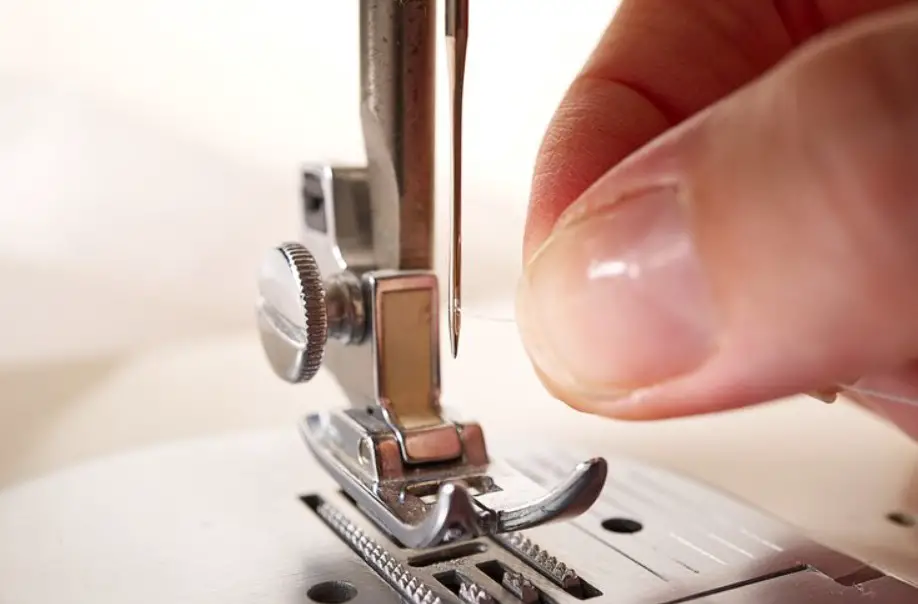
What size sewing machine needle should I use for cotton?
What size sewing machine needle for cotton? Medium-size universal needles 12/80 or 14/90 work well with cotton. The eye of a needle of this size easily passes everyday polyester thread.
If you are sewing or quilting cotton, you can use a sharp 12/80 or 14/90 needle instead. You see experts recommend using cotton points all the time because their pointed tips glide through light fabrics so easily.
How does a sewing machine needle work?
Simply put, your sewing machine’s needle carries the thread to the opposite side of the fabric to create stitches. When you watch your sewing machine work, you probably notice the bright flash of the needle going in and out of the fabric so fast that sometimes you can just see the silvery spot! This simple process involves more complex engineering than you might think.
Household sewing machines have several easily replaceable parts. If you are a beginner seamstress, you may not know that you can insert and remove the needle from the machine in a few simple steps! This allows you to find the right needle for every project you sew.
To help you understand how a sewing machine needle works, check out this breakdown of each part of the needle. Then you’ll get a clearer idea of why different shapes and sizes are better for different types of fabric.
How long do sewing machine needles last?
As a general rule, the sewing machine needle should be replaced after about eight hours of sewing or after two bobbins of thread have been sewn. You can also listen to the sound of the needle piercing the fabric. If instead of slipping silently, it starts making popping sounds, you probably need to change the needle.
If it’s easier to remember, you can always insert a new needle at the start of a new sewing project. And of course, you’ll want to change the needle to match the type of fabric you’re planning to work with!
Special coatings such as titanium can in some cases increase the service life.
Another major reason you will need to insert a new needle is chips or breakage. Sometimes pulling the fabric too tight instead of letting the machine move the fabric with the feed dogs can cause the needle to break.
Finally, one of the main reasons for choosing the right type and size of sewing machine for the job is that using the wrong needle can cause it to break! If you are using a thin leather needle, it will most likely break immediately.
To dispose of the old sewing machines, simply place them in an airtight container, such as a pill bottle. They are also accepted by some recycling or scrap centers.
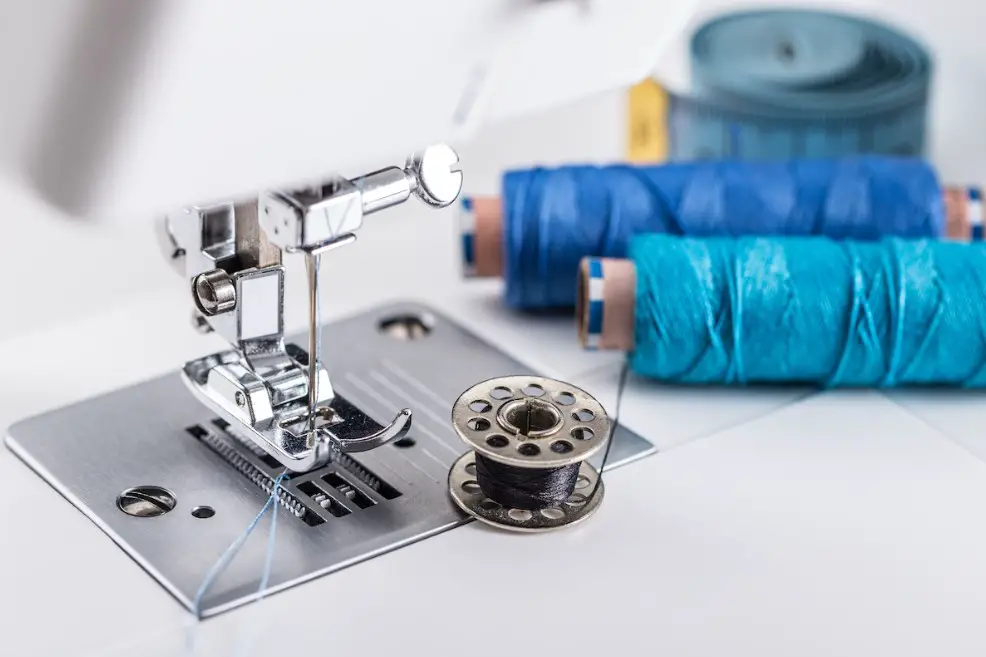
What do the size numbers on sewing machine needles mean?
You may have questions about how needle size works, such as needle size 80/12 or 110/18 for cotton. Of the two rooms, one is European and the other is American. From the thinnest to the thickest needle, European sizes range from 60 to 110, while US sizes range from 8 to 18. If you use a 70/10 needle to sew two jeans, the needle is likely to go out of service very quickly.
Explanation of the size chart of sewing machine needles
Use this chart to determine what size cotton sewing machine needle you need for your project.
- Type of fabric: For lighter fabrics such as muslin or organza.
- Needle size: 60/8.
- Type of fabric: cotton cambric, polyester, and lining fabrics
- Needle size: 70/10.
- Type of fabric: cotton, quilting cotton, linen, mixed fabrics, and wool.
- Needle size: 12 (80).
- Type of fabric: Wool, silk, linen.
- Needle size: 90 (14).
- Type of fabric: Heavyweight fabrics such as canvas, weft, and denim, thick, double-sided, or quilted thread.
- Needle size: 16 (100).
Tips for choosing the right sewing machine needle sizes
When it comes to choosing the right needle sizes, there is no one size fits all. Different types of fabric will require different sizes of needles.
As a general rule, it is always a good idea to have a variety of needle sizes and shapes on hand, so you can choose the best one for the project you’re working on.
A needle that is too large for the fabric may wrinkle the fabric, and a needle that is too small may not hold the thread.
When choosing a needle, consider the weight and thickness of the fabric. Thicker fabrics require a thicker needle, while finer fabrics require a thinner needle.
Various types of thread require other types of needles. Thicker threads require a larger needle, while thinner threads work best with a smaller needle.
The needle is available in various sizes. The most common sizes are 70/10, 80/12, and 90/14.
Some projects require a specific type of needle. Quilting often requires a quilting needle, while denim may require a denim needle.
If you are not sure what type of sewing machine needle to use, check your owner’s manual to see if the ideal size is listed. Most machines work with a needle larger and smaller than the recommended size, but using the wrong size can damage your machine.
It is important to use the proper tools when working with any type of fabric so that they are not damaged by over-stretching and pressure tearing of thicker fabrics such as denim or heavy fabrics.
If you sew for a long period of time, the fabric may lean on the needle, causing it to warp. It is recommended not to sew heavy fabric for a long time with the same needle.
When your project is complete, be sure to remove the needle and insert it into its protective cap. This will help keep your needle in good condition.
FAQ
What is a 90 14 needle used for?
For medium-weight fabrics such as corduroy, smooth bristles, and lighter-weight fabrics.
What is a 80 12 needle used for?
The most commonly used are cotton, viscose, and blends.
What is a 80 11 needle used for?
Suitable for medium fabrics, cotton, linen, and satin.
Conclusion
The sewing machine needle is the most important part of a sewing kit. The wrong size or shape can damage the fabric and ruin the finished product. It is wise to have different sizes on hand for different projects.
You also need to make sure you know how to properly use a sewing machine before you start any project; otherwise, things could end in disaster. Now you know what size sewing machine needle for cotton!
Read also: How To Sew Stretch Fabric – 8 Best Tips for Success!

Hi everyone and welcome to my blog!
My name is Liz, and I started sewing when my son was born. First I repaired the holes in children’s pants, then I dared to do more challenging projects like sewing home decor and children’s clothing. Now it is my hobby where I come to rest, let my creativity run wild, and create things that please me and enhance my home.
I would love to help other sewing beginners and enthusiasts through my blog by sharing tips and tricks for this great hobby.
